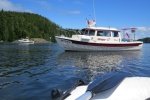thataway
Well-known member
- Joined
- Nov 2, 2003
- Messages
- 21,695
- Reaction score
- 68
- C Dory Year
- 2007
- C Dory Model
- 25 Cruiser
- Hull Identification Number
- DOR25652A707
- Vessel Name
- thataway
Today there was a story posted on The Hull Truth by a Coast Guard Officer about a rescue done over the weekend out of New Orleans. I don't think it hurts for all of use to remember to check our emergency gear.
It involved a professional mariner (crew boat captain) and his newly acquired Wellcraft 20, his family of wife and two young children. They had planed their first trip in the "new" boat. A com check at launch revealed his VHF radio was not working. So he drove over an hour to secure a new VHF Radio and installed it.
That evening the boat began taking on water. The Captain sent a MayDay call, but didn't know how to properly read his hand held GPS and give location. CG Sector New Orleans responded. As the boat sank, it turtled and the ditch bag was left at the console. It also had not been fully closed, so the VHF hand held was ruined. there were some intact flares.
The initial search of several hours did not find the boat based on his possible location. Then they tried to re-create a line of position using RDF equipment at the com center. At this point there was a cutter, several private vessels two Helos and one airplane involved. Eventually the air craft spotted a human heat signature at 10 miles with their FLIR. (Infra Red heat signature detection) Also a flare heat signature can be seen many miles away by a search and rescue air craft--even better if they have FLIR. Save the flares until you hear or see an airplane after the initial one or two.
The family was saved. They all had on life jackets.
If there had been DSC with MMSI properly installed the initial mayday would have included the digital Lat and Long. If there had been a waterproof VHF hand held, like the Standard Horizon with DSC and MMSI number, installed, it would have directed rescue immediately. If there had been a PLB or EPRIB in the ditch bag it would have almost immediately brought rescue.
Especially for newer boaters:
!. Have DSC enabled by putting your MMSI number into your fixed VHF radio and know how to use it.
2. Have a waterproof DSC enabled hand held VHF marine radio, with the MMSI number.
3. Have flares and survival gear in a water proof ditch bag you can grab as you leave the boat. I keep ours right by the helm. It also goes in the dinghy with us.
4. Have a PLB or EPRIB aboard and know how to use it.
5. Have proper life jackets and wear them if necessary.
Be safe.
It involved a professional mariner (crew boat captain) and his newly acquired Wellcraft 20, his family of wife and two young children. They had planed their first trip in the "new" boat. A com check at launch revealed his VHF radio was not working. So he drove over an hour to secure a new VHF Radio and installed it.
That evening the boat began taking on water. The Captain sent a MayDay call, but didn't know how to properly read his hand held GPS and give location. CG Sector New Orleans responded. As the boat sank, it turtled and the ditch bag was left at the console. It also had not been fully closed, so the VHF hand held was ruined. there were some intact flares.
The initial search of several hours did not find the boat based on his possible location. Then they tried to re-create a line of position using RDF equipment at the com center. At this point there was a cutter, several private vessels two Helos and one airplane involved. Eventually the air craft spotted a human heat signature at 10 miles with their FLIR. (Infra Red heat signature detection) Also a flare heat signature can be seen many miles away by a search and rescue air craft--even better if they have FLIR. Save the flares until you hear or see an airplane after the initial one or two.
The family was saved. They all had on life jackets.
If there had been DSC with MMSI properly installed the initial mayday would have included the digital Lat and Long. If there had been a waterproof VHF hand held, like the Standard Horizon with DSC and MMSI number, installed, it would have directed rescue immediately. If there had been a PLB or EPRIB in the ditch bag it would have almost immediately brought rescue.
Especially for newer boaters:
!. Have DSC enabled by putting your MMSI number into your fixed VHF radio and know how to use it.
2. Have a waterproof DSC enabled hand held VHF marine radio, with the MMSI number.
3. Have flares and survival gear in a water proof ditch bag you can grab as you leave the boat. I keep ours right by the helm. It also goes in the dinghy with us.
4. Have a PLB or EPRIB aboard and know how to use it.
5. Have proper life jackets and wear them if necessary.
Be safe.

